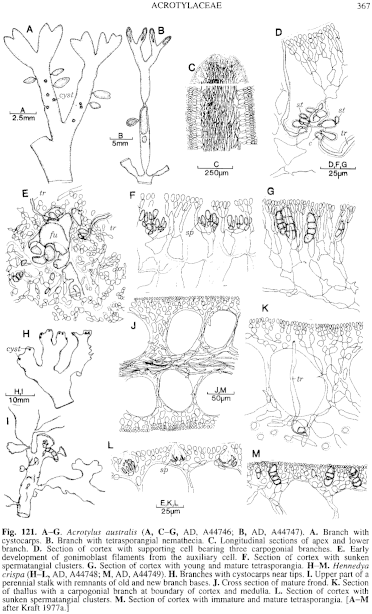|
|
|
|
|
|||||||||||
|
Electronic Flora of South Australia Species Fact Sheet
Phylum Rhodophyta – Class Florideophyceae – Order Gigartinales – Family Acrotylaceae
Selected citations: J. Agardh 1876: 541. Kraft 1977a: 113, figs 5, 6, 14. Kützing 1869: 14, pl. 37a, b. Kylin 1932: 68, figs 20C, 21A; 1956: 308, fig. 239A. Lucas & Perrin 1947: 147, fig. 21. Schmitz & Hauptfleisch 1897: 351, fig. 214C.
Thallus (Fig. 120C) medium to dark red-brown, cartilaginous, 5–20 cm high, subdichotomous to alternately and more or less complanately branched, upper branches undulate, (2–) 4–10 mm broad (narrower above) and 150–400 µm thick, with broad, notched, apices, lower parts in older plants (Fig. 121I) becoming stalk-like by thickening of the central blade and loss of margins, often proliferous from the stalks. Holdfast discoid-conical, 2–15 mm across; epilithic or on shells. Structure multiaxial, developing a relatively narrow filamentous medulla and a pseudoparenchymatous cortex, with the inner cells on both sides forming a distinctive layer (Fig. 121J) of large, isodiametric cells 60–100 µm across, with some small cells between them and the small-celled outer cortex 3–5 cells thick, outermost cells 2–4 µm in diameter. Rhodoplasts laminate, 1–3 per cell.
Reproduction: Sexual thalli monoecious; procarpic. Carpogonial branches (Fig. 121K) 2-celled, borne singly on a supporting cell just inside the large inner cortical cells, inwardly directed with reflexed trichogynes. Supporting cell acting as auxiliary cell, with numerous nutritive filaments produced from adjacent vegetative cells; gonimoblast initials several, rounded, developing filaments which line a cavity formed by breakdown of the auxiliary and adjacent cells, and forming centripetal interlinked filaments with terminal obovoid carposporangia 12–18 µm in diameter. Cystocarps (1–3) submarginal near branch apices (Fig. 121H), protruding and sometimes basally constricted, 0.7–1 mm across, with filamentous enveloping tissue and a cortical ostiole (Fig. 120D). Spermatangial clusters (Fig. 121L) urceolate, 12–20 µm across, sunken in the outer cortex, with 4–5 initials each forming a single ovoid spermatangium 1–2 µm in diameter.
Tetrasporangia (Fig. 121M) scattered in young branches, lying within the outer cortex and pit-connected to mid cortical cells, ovoid, 30–40 µm long and 15–25 µm in diameter, zonately divided.
Type from Garden or Rottnest Is, W. Aust.; lectotype from Rottnest I., in Herb. Harvey, TCD (Tray. set 168).
Selected specimens: Point Moore, Geraldton, W. Aust., drift (Womersley, 17.ix.1979; AD, A51179). Houtman Abrolhos, W. Aust., 22 m deep 20 km NW of Wallabi Group (France, Feb. 1979; AD, A51708). Port Denison, W. Aust., drift (Kraft 1787, 6.vii.1966; AD, A44748 and Kraft 4022, 14.xii.1971; AD, A44749). Point Phillip, Rottnest I., W. Aust., 7 m deep (Borowitzka, 6.xii.1984; AD, A56651). Point Clune, Rottnest I., W. Aust., 12 m deep (Kraft & Ricker, 2.xii.1980; MELU, A35524).
Distribution: GeiaAdton and the Houtman Abrolhos, W. Aust., to Pearson I., S. Aust.
Taxonomic notes: Eyre, W. Aust., drift (Woelkerling, 22.xi.1968; AD, A34234). Petrel Bay, St Francis I., S. Aust., 24 m deep (Shepherd, 11.i.1971; AD, A38129). Pearson I., S. Aust., 22 m deep (Shepherd, 12.i.1969; AD, A34019).
Hennedya crispa is a deep water alga of western affinities, easily recognisable by the notched apices and layers of large isodiametric cells on each side of the medullary filaments.
References:
AGARDH, J.G. (1876). Species Genera et Ordines Algarum. Vol. 3, Part 1 - Epicrisis systematis Floridearum, pp. i-vii, 1–724. (Weigel: Leipzig.)
HARVEY, W.H. (1855a). Some account of the marine botany of the colony of Western Australia. Trans. R. Ir. Acad. 22, 525–566.
HARVEY, W.H. (1859a). Phycologia Australica. Vol. 2, Plates 61–120. (Reeve: London.)
KÜTZING, F.T. (1869). Tabulae Phycologicae. Vol. 19. (Nordhausen.)
KRAFT, G.T. (1977a). Studies of marine algae in the lesser-known families of the Gigartinales (Rhodophyta). I. The Acrotylaceae. Aust. J. Bot. 25, 97–140.
KYLIN, H. (1932). Die Florideenordnung Gigartinales. Lunds Univ. Årsskr. N.F. Avd. 2, 28 (8), 1–88, Plates 1–28.
KYLIN, H. (1956). Die Gattungen der Rhodophyceen. (Gleerups: Lund.)
LUCAS, A.H.S. & PERRIN, F. (1947). The Seaweeds of South Australia. Part 2. The Red Seaweeds. (Govt Printer: Adelaide.)
SCHMITZ, F. & HAUPTFLEISCH, P. (1897). Gelidiaceae, Acrotylaceae, Gigartinaceae, Rhodophyllidaceae, Sphaerococcaceae, Rhodymeniaceae, pp. 340–405, Grateloupiaceae, Dumontiaceae, Nemastomaceae, Rhizophyllidaceae, Squamariaceae, pp. 508–537. In Engler, A. & Prantl, K., Die nattirlichen Pflanzenfamilien. T. 1. Abt. 2. (Engelmann: Leipzig.)
The Marine Benthic Flora of Southern Australia Part IIIA complete list of references.
Publication:
Womersley, H.B.S. (14 January, 1994)
The Marine Benthic Flora of Southern Australia
Rhodophyta. Part IIIA, Bangiophyceae and Florideophyceae (to Gigartinales)
Reproduced with permission from The Marine Benthic Flora of Southern Australia Part IIIA 1994, by H.B.S. Womersley. Australian Biological Resources Study, Canberra. Copyright Commonwealth of Australia.
Illustrations in Womersley Part IIIA, 1994: FIGS 120 C, D, 121 H–M.

Figure 120 enlarge
Fig. 120. A, B. Acrotylus australis (A, AD, A44747; B, AD, A44746). A. Habit. B. Cross section of thallus with cystocarp and ostiole. C, D. Hennedya crispa (AD, A44749). C. Habit. D. Cross section of thallus with cystocarp and ostiole. [B, D as in Kraft 1977a.]

Figure 121 enlarge
Fig. 121. A–G. Acrotylus australis (A, C–G, AD, A44746; B, AD, A44747). A. Branch with cystocarps. B. Branch with tetrasporangial nemathecia. C. Longitudinal sections of apex and lower branch. D. Section of cortex with supporting cell bearing three carpogonial branches. E. Early development of gonimoblast filaments from the auxiliary cell. F. Section of cortex with sunken spermatangial clusters. G. Section of cortex with young and mature tetrasporangia. H–M. Hennedya crispa (H–L, AD, A44748; M, AD, A44749). H. Branches with cystocarps near tips. I. Upper part of a perennial stalk with remnants of old and new branch bases. J. Cross section of mature frond. K. Section of thallus with a carpogonial branch at boundary of cortex and medulla. L. Section of cortex with sunken spermatangial clusters. M. Section of cortex with immature and mature tetrasporangia. [A–M after Kraft 1977a.]

|
Email Contact: State Herbarium of South Australia |

|